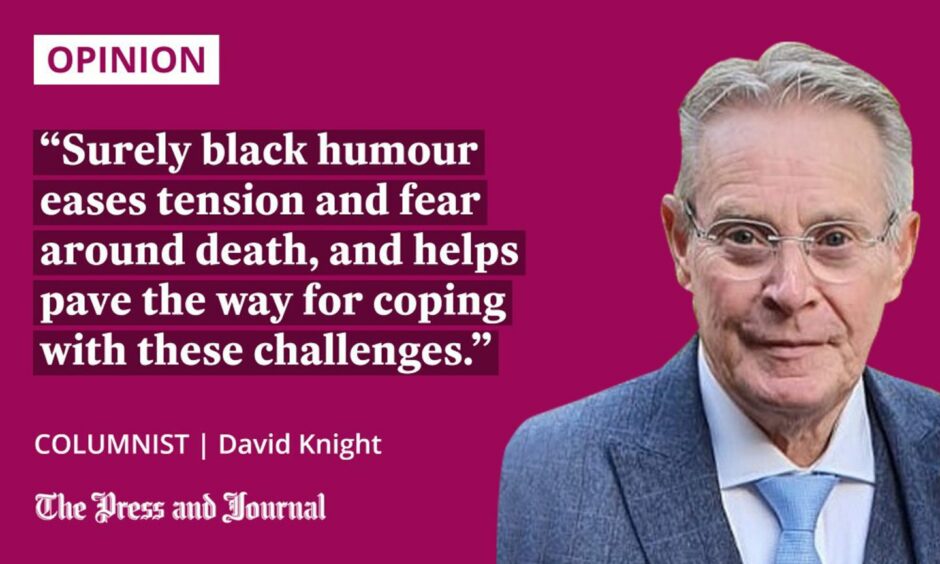We hadn’t laughed so much in ages even though we happened to be sitting in a funeral parlour.
Not the place you’d expect it, especially as we were busy planning my mother-in-law’s cremation.
Surely black humour eases tension and fear around death, and helps pave the way for coping with these challenges.
At the extreme end, we have Eric Idle singing “Always Look on the Bright Side of Life” while being crucified in Life of Brian.
The film caused outrage in some places yet didn’t Christ preach about looking on the bright side in The Sermon on the Mount?
“Let tomorrow take care of itself”.
Or what about Oscar Wilde on his deathbed in a dowdy Paris hotel?
“The wallpaper and I are fighting a duel to the death.”
‘Her deadpan eye for detail brought the house down’
What triggered us off at the undertakers was a matter-of-fact observation from my wife, just as the solemn process was about to begin.
“Have you noticed the mirrors on the wall are exactly the same as the ones in our bedroom?” she piped up.
And so they were: a neat row of small heart-shaped mirrors across the wall, just like they were above our bed.
There was silence for a split second, but her deadpan eye for detail brought the house down.
We were in hysterics; the two women from the undertakers who were assisting us followed suit.
“What does that say about us if our bedroom decor matches a funeral parlour?” I blurted out.

I think they offered to sell their mirrors to us at one point – to enhance our set – after it became a running joke throughout the process.
But laughing was cathartic; it made the whole funeral thing less grisly.
My mother-in-law is still with us, happily.
But for how long?
She’s a few months away from 91, but dementia has also pushed her further away from us into that fearful mental wilderness.
It just seemed sensible to put a funeral plan in place now rather than panic and stress out when the fateful day comes.
For most, it’s a long-term plan, but it was harder here as the end might be just around the corner.
My wife explained her mom didn’t want any fuss like David Bowie, who went direct to the crem. A cardboard box would suffice.
Then we discovered a cardboard box would cost £500 – double the cheapest coffins.
And before you think you can take along one of your old Amazon boxes, these are specially-made ones – environmentally friendly and all that.
We had sped south days earlier as she had also been in hospital for several weeks with a combination of problems.
Meanwhile, social workers were gathering to assess her for permanent residential care.
We found ourselves in that stressful bleak world of choosing care homes and facing eye-watering costs in readiness for what appeared inevitable.
Dementia is following a painful path that many of you have trodden already
I know I am following a painful path along which many of you have trodden already.
It was visiting time and we were back on the hospital ward to see my wife’s mother.
It was a discharge ward where older female patients were prepared for going home.
They had a varied list of ailments, but dementia appeared to rule the roost.
Incredibly, there was lots of stoic humour here, too. But you didn’t know whether to laugh or cry most of the time.
A couple of men spoon-fed their incapacitated wives while whispering encouragement with smiles and jokes.
A woman opposite kept pleading at random to anyone in earshot, “Excuse me, can you please help me?”
The problem was she was shouting it out up to five times a minute, 24 hours a day while banging on a table.
Staff and visitors smiled with compassion, but tempers were fraying among fellow patients trapped in their beds.
“I’m not eating a Cornish pastie for breakfast,” mother-in-law complained indignantly. “It’s only quarter to six in the morning.”
“No mom,” my wife said gently. “It’s quarter to six in the evening.”
You have to hand it to nurses on wards like this; worn out, but still smiling.
But the system doesn’t help.
They were trying to discharge her into a care home miles away even though she was due for an important heart scan the next day in a clinic – one floor below the ward.
If that sort of thing is replicated daily in UK hospitals how much is being wasted on needless transport costs?
Luckily she stayed put, but the next day they rang us half an hour before the appointment and asked, “Can you come over to the hospital and push her down to the clinic in a wheelchair?”
We couldn’t make it; I still don’t know why they asked.
David Knight is the long-serving former deputy editor of The Press and Journal

